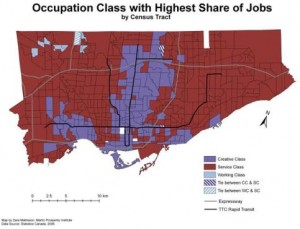Many researchers in Toronto have become experts at mapping the city’s spatial, cultural, ethnic, and political trends. A few years ago, the Globe and Mail even published a language map of Toronto based on the 2001 Census data for mother tongue. Richard Florida is now one of the latest to use the excellent mapping and research resources available at the Centre for Urban and Community Studies (CUCS).
Florida’s map shows the same differentiation that David Hulchanski did three years ago in his excellent report Toronto divided: A tale of three cities. This report received a lot of media attention, in part because its complexity and rigor left little doubt in its findings: Hulchanski, Associate Director (Research) of CUCS, carefully mapped many different characteristics using Census data spanning a thirty-year period, including income, housing tenure, transit use, ethnicity, immigration status, household size, and employment. The carefully-worded report raised some red flags: the decline of the middle class, the decrease in housing choices for low-income households, the shift of poor neighbourhoods from the inner city to the outer suburbs.
It’s common to say that people “choose” their neighbourhoods, but it’s money that buys choice. Many people in Toronto have little money and thus few choices…When most of the city is in a middle-income range, city residents can generally afford what the market has to offer…It is only when the percentage of those in the middle declined that we began to hear about “housing affordability” problems. If the incomes of a significant share of people in a city fall relative to the middle, the gap between rich and poor widens. Those closer to the bottom are more numerous and find it increasingly difficult to afford the largest single item in their budget–housing (either in mortgage payments or rent). J. David Hulchanski, Associate Director (Research), CUCS
Hulchanski, who has written volumes about affordable housing policy in Canada, wrote persuasively of the policy options that can help reverse these trends, and many writers echoed his concerns. Florida himself wrote an article in response in the Globe and Mail.
Florida, on the less thorough end of the spectrum, mapped “creative class”, “service class”, and “working class” occupations in the Toronto CMA. The Geography of Toronto’s Service Class, published by the Martin Prosperity Institute at U of T, shows how the “classes” were defined. Artists, doctors, teachers, managers, architects and computer programmers were all considered “creative class”. Cashiers, salespeople, police officers, food preparers, medical assistants, and administrative assistants were “service class”. And miners, welders, carpenters, truck drivers, production workers, and construction workers were in the “working class.” If you know Florida’s work, you know that he is preoccupied with class and that he tends to use loaded terms; “class” is not a casually-used word in the Canadian research arena.
The kind of work people do is the hallmark of social-economic class and the map shows a city where the dominant classes occupy, literally, two different social, economic, and geographic spaces. Richard Florida, www.creativeclass.com

It is true that Toronto’s postindustrial shift has led to a decrease in manufacturing jobs, suburbanization of workplaces, concentration of high-paying service-sector work in the inner city, and gentrification around subway lines (all of which Hulchanski pointed out earlier, not to mention Tom Hutton and David Ley). But Florida’s definitions are directly responsible for his findings: how is a doctor in the “creative class”? A manager or computer programmer? And how do police offers and medical assistants get grouped in with cashiers and administrative assistants? It seems as though he has just mapped by salary level, not occupational category…in which case his results aren’t surprising.
Research involving income, occupation, ethnicity, and polarization need to be carefully articulated and worded to avoid clichés like “upper class people live in desirable areas while lower class people do not.” There is much more depth to the story than Florida lets on, although he is fairly well-versed in housing issues. The recently-released report on Canada’s Housing Bubble, produced by the Canadian Centre for Policy Alternatives, outlines how housing prices have risen faster than inflation, household incomes, and economic growth. Echoing Edward Jones’ report earlier this year (see my previous post), CCPA says that the housing market is “more unstable than it has been in over a generation.” All major cities in Canada are now experiencing housing price increases above their historical range, meaning the time is ripe for a crash. For Florida, who advocates the creative class and advises cities on how to bring these types to their cities, real estate is crucial: he has written about the need for more rental housing, which in his opinion keeps people mobile and able to search for employment in a wider range of locations. His recent publication on Toronto’s class divide has more to do with the city’s political landscape than housing, of course, and it has served its purpose of being provocative.
